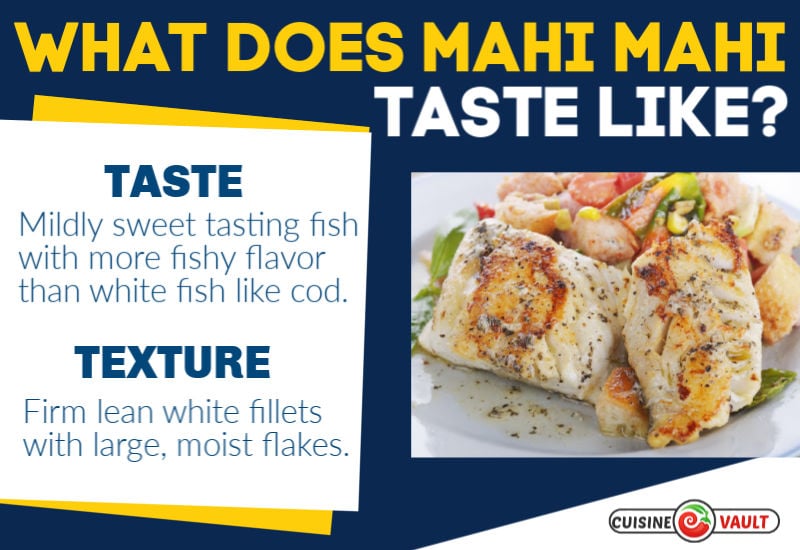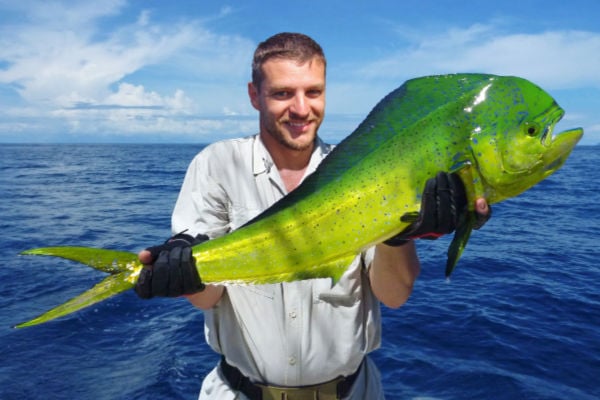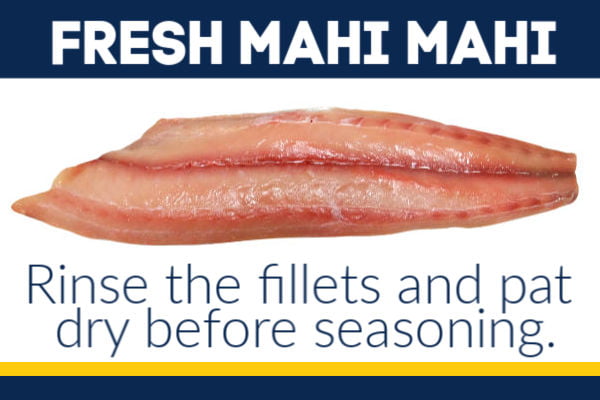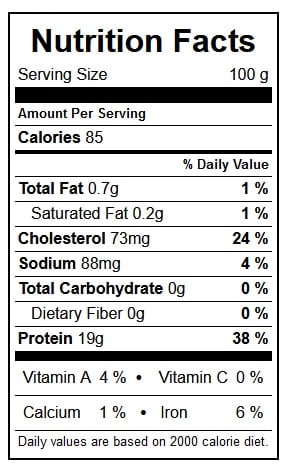Back in the 1980’s mahi mahi was known as Dolphinfish, which in hindsight, wasn’t the best name for a fish that’s sold for consumption. Customers at high-end restaurants in Hawaii and other parts of the United States were horrified to think they were eating a dolphin. To fix the problem, the menu item was renamed mahi mahi. A good move considering there is no connection between the two. Dolphins are mammals, and mahi mahi are fish.

If you're considering trying mahi mahi for the first time you may be wondering what it tastes like? Keep reading to find out more about this fish and whether you're likely to enjoy it.
What Do Mahi Mahi Taste Like?
Mahi mahi is a mild-tasting fish with a faintly sweet undertone. It has a stronger “fishy” flavor than white fish like haddock or cod but tastes milder than swordfish. Larger, mature fish generally have a stronger taste than younger ones.

The skin is thick and unpleasant to eat, so it should be discarded before cooking for most recipes. It is okay to grill mahi mahi with the skin on.
The texture of mahi mahi is firm, similar to swordfish or halibut, although not as “steak-like”. The fillet has large moist flakes when cooked. Mahi mahi has very low levels of fat and isn’t rich or oily. After eating a plate of this fish, you won’t have that same “full feeling” that you get from a large fillet of salmon.
| Feature | Description |
|---|---|
| Flavor | Mild-medium |
| Texture | Firm, large flakes |
| Fishiness | Medium |
| Oiliness | Low |
| Color (cooked) | Off white |
Further reading:
What does red snapper taste like?
Find out what wild vs farmed catfish taste like.
What does freshwater and saltwater eel taste like?
What seasonings are best with mahi mahi?
Enjoy your fish with a combination of the following simple flavors. The subtle taste and texture of the seafood is hard not to love - even when you have fussy family members or friends at the table!
- garlic
- lemon
- chili flakes
- parsley
- basil
- paprika
- onion powder
- oregano
- thyme
How to select the freshest fish
As with any fish, your best option is to catch a fresh one from the sea. However, this isn’t a simple job as these fish are fast, powerful, and not exactly an easy creature to hook on the fishing line.

Fresh mahi mahi provides the best eating experience.
If you can’t get the wild version, visit a fish market with a reputation for quality.
- Look for pinkish flesh that is almost translucent and skin with red and pink spots or stripes.
- The bloodline should appear bright red – if it’s dull brownish, then keep looking for a fresher option.
- Avoid funky smelling fish with an overwhelming fishy smell; instead, look for a more neutral smelling option.
- Fish with brown spots or dark colors are signs of fish that aren’t freshly caught and are best to avoid.
- Frozen mahi mahi is a perfectly acceptable option if you don’t have a suitable supplier nearby.
- To keep your fish fresh, wrap in plastic and store in the fridge for 3-4 days or freeze for 3-6 months.

A dull or brown colored bloodline indicated the fish isn't fresh.
Cooking advice
Best cooking options: Bake, broil, fry, grill, saute, seared, sushi
Pan-seared mahi-mahi recipe
If you’ve got your hands on some fresh mahi mahi fillets, then you’ll find them an easy fish to cook compared to many other seafood varieties. It is a forgiving protein that is harder to overcook.
Before you start this recipe, it is recommended to give the fillets a thorough rinse in cold water before patting dry with paper towels.

Rinsing and drying the fillet provides a better crust when searing.
Serves: 4. Prep time: 5 minutes. Cooking time: 20 minutes.
Ingredients
- 4 mahi mahi fillets
- Salt and pepper, to taste
- 2 Tbsp olive oil
- Juice of one small lemon
- 1 clove garlic, crushed
- ¼ cup unsalted butter, cubed
- 2 Tbsp fresh parsley, chopped
Instructions
- Season the fillets liberally with salt and pepper.
- Heat oil in a skillet on a medium-high temperature until the oil begins to smoke.
- Carefully add fish to the skillet and sear until the fish is nicely browned and you can see the fish has cooked a little over halfway through (3-4 minutes).
- Flip the fish and then continue to cook until the fish has just cooked through (2-3 minutes). Transfer them to a separate dish and set aside.
- To prepare the sauce, pour lemon juice into the skillet on medium-low heat. Add the garlic and season with salt and pepper. Stir the liquid with a wooden spoon, scraping the bottom of the pan to release all the browned pieces into the sauce.
- Add one cube of butter and allow to almost completely melt before adding the next piece. Repeat until all the butter is added. Remove from the heat and stir in the parsley.
- Pour the lemon sauce over the fillets and serve immediately. A bowl of chips or rice, along with a garden salad could also be served with your main dish.

Mahi mahi combines well with steamed greens such as asparagus.
Tips for cooking mahi mahi
- The cooking time provided in our recipe is only an estimate and will vary depending on the thickness of your fillets.
- Use a fish roaster for perfectly cooked fish every time.
- Cook 60% of the fish on the first side, then flip and cook the remaining 40%. This technique allows the first side to develop a tasty looking crust before being flipped.
- Don’t add the fish to the skillet too early. The oil needs to be smoking hot to get that lovely crust.
- Remove any excess moisture from the fish by patting dry with paper towels before seasoning.
- If you bake fish, slice a lemon thinly and place them on the top of the fish. It adds flavor and enhances the presentation when it comes to serving time.
- Remove the fish skin prior to applying the seasoning.
- For a milder tasting meal, trim off the darker sections of meat before adding the seasoning. These sections pack the most flavor.
- Don’t overcook your fish; it will become dry and unpleasant.
Quick facts
Alternate Names: Dolphinfish, Dorado
The mahi mahi lives warm, tropical oceans across the world, feeding on the fishes close to the surface. An average fish weighs about four pounds but can grow up to 30 pounds if the conditions are suitable.

Mahi mahi are a powerful, fast growing fish.
Although most mahi mahi sold in the United States is caught in Taiwan or Japan, the Hawaiian variety is considered the best eating fish. It has a firmer, whiter texture, and the fillets are considerably larger.
The mahi mahi is a beautiful looking fish, with bright green, blue, and golden scales that sparkle in the water. The male has a prominent protruding forehead while the female has a smaller, rounded head. They are powerful fish that can swim almost 60mph!
Health benefits

Nutrition information
Mahi mahi is healthy, nutritious meat offering a valuable source of protein, omega three, and essential minerals¹.
1. Low in sodium
Containing 88mg of sodium, a fillet will supply 4% of your recommended daily value. For people trying to reduce their salt intake, this is an excellent choice of protein.
2. Omega 3 Rich
Omega 3 has an array of positive health benefits, including reduced high blood pressure and offering benefits for the cardiovascular system. Maha mahi is an excellent source of Omega 3 fatty acids.
3. Low fat
Mahi mahi is a lean fish with 0.2g of saturated fat contained in a 100g fillet. If you need protein for muscle growth but would prefer to cut out fattier cuts of meat like beef or pork, this is a good option.
4. Essential minerals
Increase your intake of essential minerals like niacin, selenium, magnesium, and lysine with one serve of mahi mahi. They play a crucial role in maintaining blood pressure, bone health, new cell creation, muscle function, and much more.
Note: One fillet (100g/3.5oz) of mahi mahi contains 73mg, or 24% of your daily recommended cholesterol intake. We recommend consuming this food in moderation.
Further reading:
Find out what flouder tastes like.
Check out the taste of grouper here.
Discover what walleye tastes like here.
Final words
Mahi mahi is a firm, lean fish with medium levels of fishy flavor. People consider this fish a delicious option at restaurants, and it is a popular menu item in Hawaii. If you’re tired of salmon or cod and want something a little more adventurous, this is an excellent option. Whether you eat it at a restaurant or cook it in the kitchen at home, the lovely firm flakes combined with relatively low oil content make it a delicious, healthy seafood.
Have you tried mahi mahi? What do you think of the taste? Let us know in the comments below.
Reference:
[1] https://www.nutritionvalue.org/Fish%2C_raw%2C_mahimahi_nutritional_value.html

Leave a Reply